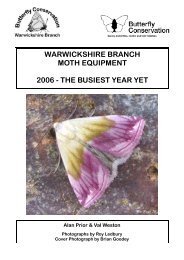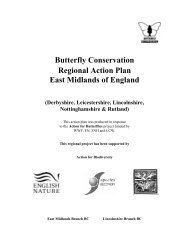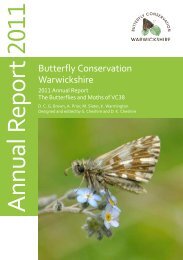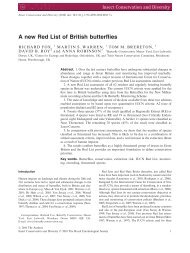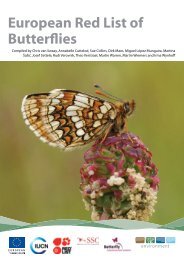2007 Magazine Version 05.indd - Butterfly Conservation Warwickshire
2007 Magazine Version 05.indd - Butterfly Conservation Warwickshire
2007 Magazine Version 05.indd - Butterfly Conservation Warwickshire
Create successful ePaper yourself
Turn your PDF publications into a flip-book with our unique Google optimized e-Paper software.
Both the disease-resistant Elms we had planted were coming into leaf, so again we<br />
were pleased. We spent some time trying to pinpoint where a Turtle Dove was calling<br />
from, but we never did see it. Three Silver Y’s and a Small White were the best we<br />
could do with flying lepidoptera, but we had enjoyed the walk.<br />
Malpass Site 7th June<br />
Twelve enthusiastic people joined me to look at this site on a day that was cloudy,<br />
bright and warm. We met in Parkfield Road but relocated to Lea Crescent because we<br />
were met by new locked gates and had to use the alternative informal entrance. This<br />
had been cleared with CEMEX’s security staff. We forged our way through tall grasses,<br />
nettles and thistles to the base of the old spoil bank disturbing Banded Demoiselle<br />
damselflies. We were soon picking up numbers of Small Heath and Large Skipper, but<br />
not in the numbers I expected. We had a glimpse of a possible first Ringlet, a couple<br />
of Meadow Browns, and brilliant – a Grizzled Skipper – a first I think for Jan. John Rea<br />
discovered a Small Copper which was rather reluctant to open its wings. The day had<br />
become overcast but it was still very warm. Moth expert Martin Kennard had quietly<br />
added to the day’s count with species whose identity defeated the rest of us. The<br />
display of Orchids on the area of chalk was impressive for those who had not seen it<br />
before, but was perhaps not as vibrant as some previous years. Numbers in the glade<br />
were very much reduced despite Cyril’s coppicing of the willow to introduce a bit more<br />
light at our recent work party. We had only seen the one Grizzled Skipper up to now but<br />
had confirmed the earlier glimpse of Ringlet by a positive sighting. We headed through<br />
the long grasses and thickening hawthorn scrub to the north east corner where the day<br />
really picked up. The sun appeared. Two Grizzled Skipper chased by at a great rate.<br />
Shouts of another Large Skipper here and I’ve got a Burnet Companion, plus confusion<br />
over where the latest sighting of Grizzled Skipper had got to and how many there were<br />
added to the fun of the afternoon. Eventually we thought there were about five. One<br />
or two Common Blue, Latticed Heath, Yellow Shell, Speckled Wood and some Small<br />
Tortoiseshell larvae were found. We eventually crossed<br />
over the large flat area where the Malpass Quarry had<br />
been years ago, finding Bee Orchid, Meadow Vetchling<br />
and the first Knapweeds in flower. The<br />
increased amount of nectar sources<br />
brought an increase in sightings with more<br />
Grizzled Skipper to total seven for the day,<br />
Painted Lady, and Latticed Heath added<br />
to the list. We also found the lovely plant<br />
Grass Vetchling – a member of the pea family<br />
– its leaves look like grass and it has the most<br />
delicate pinkie/violet flower on a very long<br />
stem. The flowers only last for a day or two.<br />
The day had built up to a fine finish with lots<br />
of sunshine, butterflies and flowers. We all<br />
agreed it was a very successful walk. We<br />
appreciated CEMEX allowing us access to<br />
this site.<br />
Female Large Skipper<br />
Photograph © Steven Cheshire <strong>2007</strong><br />
Phil Parr<br />
32<br />
<strong>Butterfly</strong> <strong>Conservation</strong> <strong>Warwickshire</strong> Branch <strong>Magazine</strong> <strong>2007</strong>




